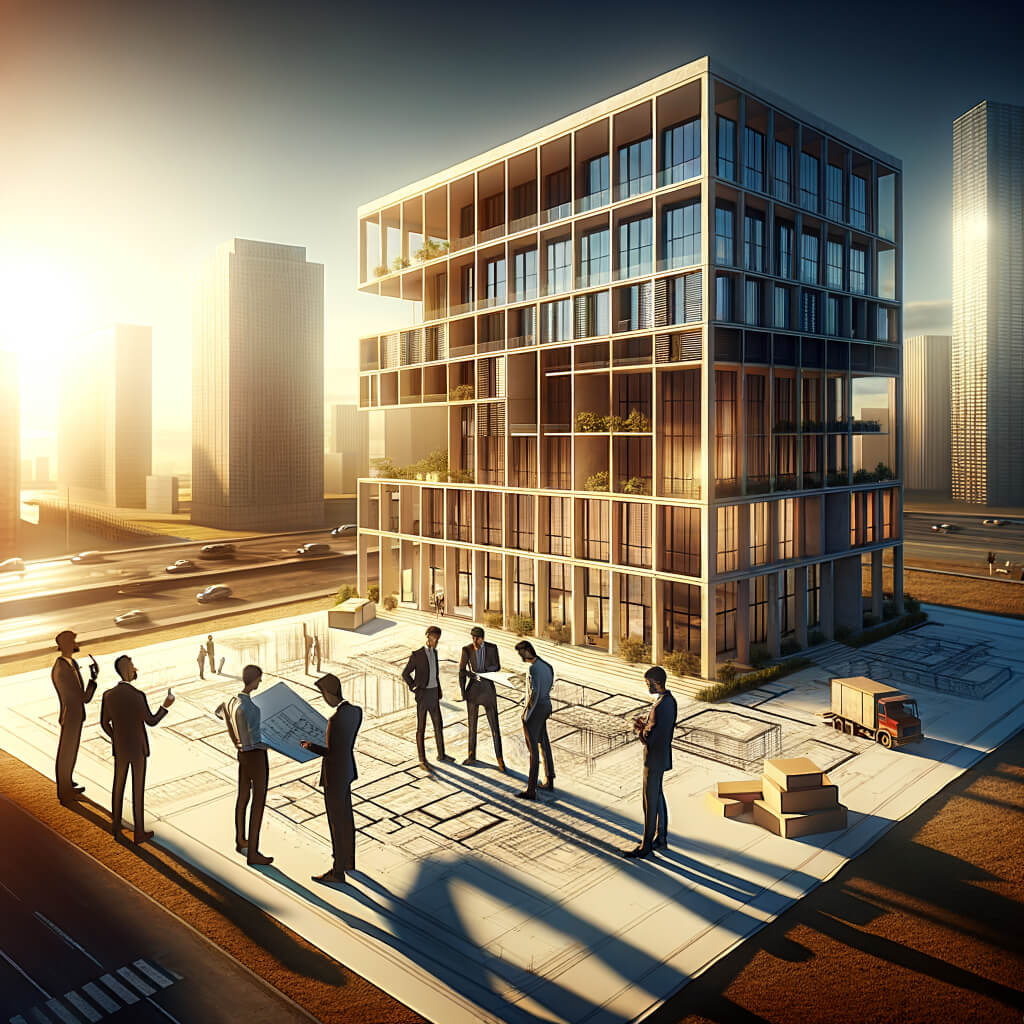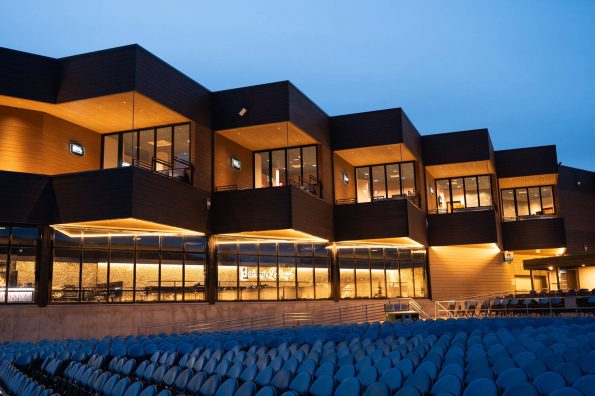There are many things to consider before investing in a commercial property and we believe that getting an experienced commercial architect involved early can help guide you to purchasing the right property for your needs.
Here are the 10 key Review Variables that we recommend evaluating with a commercial architect before you commit to buying a property:
- Client Needs & Design Potential
- Structural Review
- Sustainable Design Opportunities
- Soil Composition & Geotech
- Water Quality & Testing
- Water Infrastructure
- Sewer System Evaluation
- Electrical Service
- Building Construction
- Building Code Review (NFPA/IEBC/IRC)
To learn more about site selection and the variables that should be reviewed before purchasing real estate, be sure to read our post — Should You Hire an Architect Before You Buy a Property?
As you can see, there is a little bit more to evaluating a real estate purchase than just picturing yourself sipping bourbon and enjoying the ROI (Return on Investment) for the property. Getting to that point can be a long road and one that must start with a cost/benefit analysis of purchasing the property. Hiring an architect to take a look at the said property is an essential step in generating an accurate analysis.
Let’s take a look at how the Review Variables affect purchasing an existing commercial property.
Existing Commercial Spaces
To be fair, there is value in purchasing an existing commercial building. Not only are you purchasing already installed materials, systems, and infrastructure which can give you a cost advantage over building new, but you are also purchasing a functional building where it is very likely that several of the “Review Variables” are already in good standing.
Water Quality & Testing
Most commercial buildings are tied to municipal infrastructure, but not always. Regardless of whether the building operates off municipal potable water or well water, you should test your drinking water. This may seem to be a silly notion for an existing commercial building but both well water and municipal water can have harmful levels of contaminants that can affect the health of those drinking it. Specific contaminants in drinking water can vary depending on the water source and treatment processes. Some of the potentially harmful chemicals and pathogens that may be present in drinking water include:
- Bacteria and Viruses
- Parasites
- Chemical Pollutants (such as Heavy Metals, Pesticides/Herbicides Industrial Chemicals)
- Disinfection Byproducts, Nitrates, and Radionuclides
A variety of factors can contribute to poor water quality:
- The quality of the water could become compromised at the source
- The conveyance system (piping) could become compromised.
Just because water has been tested and passed at some point, doesn’t mean that these factors can’t crop up and threaten the health of the inhabitants, and consequently threaten the health of investment.
More specifically, it’s important to note that water treatment plants are designed to remove or reduce contaminants to safe levels but they aren’t always successful. Unforeseen environmental factors could be playing a part in contaminating a water supply. The presence of contaminants can fluctuate with environmental factors. Always get a firm grasp on where your water is coming from. Potable water, though likely once pure, can suddenly become contaminated without apparent evidence or forewarning. Regular water quality testing and monitoring are critical to ensuring that drinking water meets safety standards. If you have concerns about the quality of your drinking water, you can contact your local water utility for information on water testing results and treatment processes.
You also may have aging water pipes that are leaching into the drinking water as it circulates throughout the building. So it is always important to test at the faucet and not where the water enters the building. Rest assured, filtration can be added (and probably should be anyway) usually in a relatively inexpensive manner.
To err on the side of caution, it is critically important to have any drinking water rigorously tested before the acquisition of your commercial building.
Water Infrastructure
If poor water quality is discovered, it may be an indication of problems with the conveyance system. However, clean water doesn’t necessarily get you off the hook on evaluating water infrastructure. In addition to having the water tested for your commercial building, the specs of the water conveyance system should always be reviewed. More specifically:
- What is the age of the piping?
- What is piping made of?
- What is the diameter of the piping?
- What is the existing pressure (psi) of your water supply?
- Can the existing pressure at the main, handle a sprinkler system if required? (Particularly important if you are looking into a mixed-use or multifamily building with housing units on upper floors.)
Sewer System Evaluation
Existing commercial buildings also suggest the presence of a functional sewer system (either septic or municipal/city sanitary sewer). Similar to the review process with the water infrastructure, the sewage conveyance and treatment system should also be reviewed. The conditions with which sewage leaves your potential building should be reviewed.
- What is the age of the piping?
- What is piping made of?
- What is the diameter of the line?
- What is the capacity of the service?
If you are looking at an older property that was built to dated commercial construction standards we often find that the existing sanitary sewer lines are often undersized. If additional fixtures such as toilets or sinks are to be added as part of a likely future renovation, you must take a look at the capacities of the piping to accommodate these increases in black water and gray water flow before purchase.
Additionally, any onsite sewage treatment should also be reviewed before purchase.
- septic tanks
- leach fields
- additional localized municipal sewer requirements
Soil Composition and Geotech
It isn’t always necessary to look at your soil composition. You might be able to get away with not looking deeper only if you aren’t planning an addition or expansion. Before getting a soil test we need to determine if any of these scenarios apply:
- Is the building close to a freshwater or saltwater watershed?
- Is the building on a hillside?
- If so does it show signs of differential settlement in the facade or foundation?
If you answered yes to any of these scenarios, you need to take a closer look at soil composition. Testing the soil will establish if unreliable soils are present which might lead to differential settlement such as:
- Aqueous soil — soil that is saturated with water at least some of the time)
- Amorphous soil — soil that might move depending on the presence of erosion either above the surface or subsurface
- Inconsistent soil — a building footprint that might include soil strength in one area but weakness in another.
All of these scenarios will, eventually, produce problems of varying degrees in an existing commercial building.
This doesn’t always mean that borings and outright geotech analysis are required. A skilled architect can interpret how the building is behaving structurally by taking note of certain indicators, and this can be a less invasive and less costly way to perform some geotechnical analysis — albeit incomplete.
If the intent is to add onto a building, all of these soil conditions can be addressed. Structural fill can be added, subsurface drainage systems can be built, and even cofferdams can be built to protect the existing structure as well as the new addition from tidal activity, soil saturation, seasonal aquifers, etc.
We will not be getting into the implications of every subsurface situation in this blog, but if you have a question please feel free to reach out to us.
It is very important to establish the presence of bedrock as this can present significant costs as well as benefits depending on its location in relation to a proposed foundation. It can prove to be extremely costly and risky to start blasting and cutting away bedrock, especially in proximity to your existing building or others that may be nearby. Additionally, it can provide an excellent support material to a foundation that will remove the need for structural fill in most cases.
An additional benefit of understanding subsurface soil conditions is getting an early read on the presence of granite which produces radon and may affect air quality within the building as well as the quality of the drinking water. And so you see, these site conditions are often inextricably linked to others.
Building Construction
As alluded to earlier, not only are you purchasing installed infrastructure and materials that can give you a cost advantage over building new, existing commercial buildings also contain embodied value if you have a discerning eye that can value construction quality and building systems effectively. Construction techniques, materials used, and building systems all need to be evaluated before purchase. Additionally, the age and state of these items are of the utmost importance to be inspected and evaluated using an Architect.
The key construction elements of a commercial building that cannot be ignored are:
- structural integrity — member sizes and condition
- thermal envelope — R-value in the walls
- waterproofing envelope
- age and efficiency of HVAC/P — Heating, Ventilation, Air Conditioning, and Plumbing
- window age and quality
- electrical wiring
These are just a few of the necessary areas of building construction that need to be reviewed.
Air Quality
Evaluation of air quality in your commercial building is often overlooked but can uncover major issues that may otherwise go undetected. With incidences of mold exposure on the rise, and radon gas common in bedrock conditions, it is critically important that rigorous air testing is done. Due to air quality issues that our clients have encountered with adaptive reuse (also called building reuse) and renovations of the older masonry buildings commonly found in Maine and New England, we recommend against purchasing a masonry building unless the exterior of the building has been sealed or you plan on sealing it.
We also recommend not purchasing the building if the exterior of the foundation has not been waterproofed. Basements that have not been waterproofed are notorious for producing environments with poor air quality. We will advise on necessary interior foundation repair and waterproofing to ensure that the lack of exterior waterproofing does not negatively impact the air quality of the building long term.
Electrical Service
Seasoned commercial developers understand that line item “electrical service upgrade” better than anyone. Most other commercial building owners learn the hard way about the necessity of an electrical service upgrade. It is one of the most common, and costly, misses in evaluating a commercial building.
Current and future electrical needs need to be evaluated before purchase. New equipment that is electrical load heavy needs to be sorted. The future requirements of existing commercial buildings need to be fully understood. Coordination with local utility companies, the city/town, and review of lead times on panels all must be reviewed to temper client expectations. That is, all of these items need to be better understood before purchase.
Structural Review
It is absolutely mandatory that you conduct a full structural review of your commercial building before purchase. Current structural capacities and any existing indicators of structural stress need to be reviewed and well-documented. At a bare minimum, the current structure needs to be assessed as to whether it is capable of meeting the demands that existing dead load, live load, and soil capacities are placing on the structure itself.
What does this mean? Well, it might be a bit shocking, but you need to take stock of the sizes, conditions, and species of all structural members in your building as it relates to the use of the space.
Framing Members in Your Walls, Floors, and Roof
- Wood
- Steel
- Concrete
- LVT—luxury vinyl tile
- Glulam—glued laminated timber, etc.
Foundations
- CMU Block
- Stone
- Cast-in-Place Concrete
- ICF block, etc.
These are important distinctions that affect the strength of these members and the “work” these members are doing. Once this information is collected, the building can be more accurately evaluated for current structural integrity and the ability of these members to accomplish existing work and future growth.
It is worth noting that most structural members can be reinforced, repaired, or replaced. However, cracking evident in a foundation indicates potentially serious problems. Most foundations crack, even initially after construction, however, the size, angle, and location of the cracking need to be evaluated. This could indicate inadequate bearing capacity of the soil, shallow footings that are being hammered by frost, inadequate concrete mixes, hydrostatic pressure, differential settlement, and a host of other problems that may be extremely costly to fix.
Sustainable Design Opportunities
Climate change and the impending climate crisis are of serious concern but if you are a potential buyer, the importance of these factors is often relative to a potential buyer’s climate location, sense of environmental stewardship, and at times, political beliefs. However, despite the relativity of these value structures, all humans like to be thermally comfortable and to save money for future opportunities. Smart design with energy conservation in mind accomplishes both while helping the greater natural environment. The last thing you, and/or your tenants, want is to be thermally uncomfortable and consequently find yourself confronting costly expenditures to reverse this overlooked reality.
Thus a baseline energy consumption for maintaining thermal comfort year-round within a building needs to be established. This focuses on BTU consumption but should also incorporate building maintenance. Both of these fronts require that the efficiency of the HVAC systems in the building be evaluated closely, as well as understanding the exact energy demand that these systems present. Depending on the results of this analysis, additional measures may need to be allocated for and priced before purchase.
Commercial buildings are often inefficiently consuming energy. Three important upgrades can be made to reduce energy consumption:
- Improve the HVAC system.
- Add R-value (insulation) to the roof and walls
- Add smart strategies and renewable energy.
Bundled into this analysis includes evaluating the “solar and wind views” of the building, opportunities for the R-value of both walls and roof systems to be enhanced, the current amount and location of thermal mass and the ability to increase, and the presence of permanent and seasonal shading of the site architecture and the ability to manipulate.
It is critically important to understand these factors so new homeowners aren’t faced with large energy costs and poor thermal comfort.
Client Needs & Design Potential
As we discussed in our post—Should You Hire an Architect Before You Buy a Property?—it is up to you, the buyer, to do your research to find a great architect that fits your needs.
Here are 4 questions you need to ask yourself before engaging a commercial architect:
- Do they appear to be creative out-of-the-box thinkers or is their work a bit stale and all too familiar?
- Do they have relevant experience with the type of commercial building project you are pursuing?
- Do you appreciate their portfolio of work?
- Are their clients formidable and do you value their decision to use this architect?
If you answered yes to each one of these questions, you likely have a decent architect on your hands. You should then interview them and get a sense of their interpersonal skills and whether they can be an effective leader in skippering an accurate assessment of the building you have your eyes on, and more importantly, can fully understand the potential of the building to meet your needs.
Building Code Review (NFPA/IEBC) & Zoning Analysis
This category, though last, is arguably the most important as it can impact whether the building you are about to purchase can legally meet your needs. That’s quite a statement when you think about it. It implies that there could be a chance that your building may not legally meet your needs. Let’s qualify that for a second.
Depending on the age of the commercial building, there could be code violations. These violations are likely a product of another time with less restriction and less oversight. There were backroom deals in smoke-filled rooms, handshakes on golf courses, and quid-pro-quo arrangements that don’t occur today. Nobody followed building codes per se either.
Recently we evaluated a building where the second means of egress was jumping onto another building and using their fire escape…no kidding!
These conditions are usually “grandfathered” unless they immediately endanger public health. Despite a “grandfathered” status, local, state, and national building codes and local land use ordinances may have triggers that could force you to bring a building into compliance. Often, a change of Occupancy Type triggers full code compliance, though there may be some flexibility. So if you are planning on converting an office building into a nightclub, you have your work cut out for you as the code requirements for Assembly Use are much tougher than Business Use. Working with an architect before the purchase will help you plan accordingly.
You also want to be intimately aware of the zoning for your commercial property before purchase because that may prevent you from adding a restaurant, office, or daycare in a particular section of the city. You need to be intimately aware of these restrictions before purchasing.




